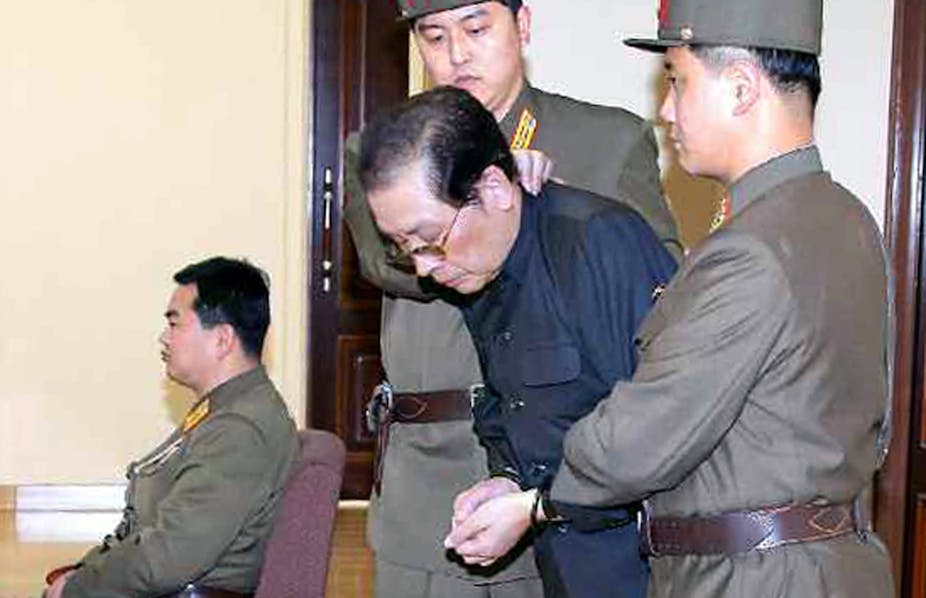In a drama reminiscent of George RR Martin’s epic book A Game of Thrones, court politics at the pinnacle of the Kim dictatorship in North Korea have taken a brutal turn with the purge and execution of the regime’s number two man, Jang Song Taek.
Rise and fall of Jang Song Taek
Jang Song Taek is North Korean leader Kim Jong-un’s uncle by marriage and husband to Kim Kyung Hee, Jong-un’s aunt and brother of Kim Jong-il, who he courted when both were students at Kim Il-sung University in the early 1970s.
Jang’s career benefited from his connection to the Kims. He became a member of the Supreme People’s Assembly in 1986 and a member of the Party Central Committee in 1992, before being elevated in 1995 to First-Vice Director of the Party Organization and Guidance Department.
Jang was purged (not for the first time) in 2004 for an alleged bid to enhance his own power, but was reinstated in 2005 to become Kim Jong-il’s right-hand man, having responsibilities for oversight of domestic intelligence, police and judicial institutions.
In April 2009, Jang was promoted to a key role within the National Defence Commission, the country’s peak military organisation, and assumed a caretaker role for domestic affairs while Kim Jong-il was unwell. Following Kim Jong-il’s death in December 2011, Jang was installed with a core group of senior figures to act as a regency while Kim Jong-un cemented his power as the new leader.
Jang’s precarious position came to international attention on November 12 when his deputies Ri Ryong Ha and Chang Su Kil were reportedly executed. After being placed under house arrest, Jang was formally placed into custody for public spectacle at the Politburo Central Committee meeting on December 8.
According to Korean Central News Agency, on December 12 he was convicted of his accused crimes at a special military tribunal of the Ministry of State security and summarily executed.
Why was Jang purged?
As anyone familiar with North Korean politics well knows, the exact machinations of the government elite in Pyongyang are murky to outside observers.
However, the spectacle of Jang’s purge and execution has been given unprecedented publicity by the North Korean government. This is both an unusually frank admission of schisms within the North Korean elite and a powerful signal by Kim Jong-un to other members of the hierarchy of his power over the institutions of state.
What is the genesis of these internal factional fractures? The past two years have been a period of rapid change in the North Korean economy. The accusations against Jang, published by Korean Central News Agency, point to his mismanagement of his economic opening portfolio as one of a number of reasons for his removal.
Jang was a known champion of a Deng Xiaoping-style opening and reform of the North Korean economy, in opposition to a rival faction within the Ministry of State Security with greater commitment to nuclear weapons development and the military-based politics of the Songun model. Jang may therefore have been the loser in this institutional power struggle.
It is also plausible that Kim Jong-un has outgrown his need for a regency and is shedding the team of senior officials installed around him by his father to ensure a smooth leadership transition. The removal of his elder protectors would be an indication that Kim Jong-un is in full control of the government.
A history of purges in the DPRK
The formative phase of authoritarian regimes usually culminates with a great purge in which the leader eliminates all other potential challengers to his power. Because there is no concept of a loyal opposition in authoritarian systems, nothing less than a monopoly of power is sufficient to ensure the security of the new regime, requiring the liquidation of all rivals.
During the post-liberation period in the 1950s, the new president Kim Il-sung slowly beginning the process of weeding out dissenters from the other factions of the North Korean revolutionary movement, which had evolved in a number of different countries with each group developing unique characteristics, with their own regional affiliations and connections to external organisations.
Kim first weakened the Soviet-Korean faction in November 1951 and by 1958 had purged the leadership core of the Yan’an and Soviet factions as well after they attempted to replace him as leader during a Korean Workers’ Party Central Committee Plenum in 1956.
Between October 1958 and May 1959, approximately 100,000 people were eliminated on political grounds. By the Korean Workers Party’s Fourth Congress in September 1961, Kim had solidified his position as absolute ruler of North Korea.
Smaller purges are undertaken periodically to clean out potentially disloyal elements from the military and bureaucracy, though no purge event has occurred on the scale of the present episode since the 1950s.
In Game of Thrones, the queen-regent Cersei Lannister states that “in the game of thrones you either win or die”. This is an apt summation of the process of leadership consolidation currently underway in Pyongyang as factional rivals vie for influence or survival under the solidifying leadership of Kim Jong-un.
Indeed, the Kim family has been remarkably efficient “coup-proofing” its rule by playing off potential institutional rivals against each other and purging individuals when become too prominent within the institutional hierarchy.

